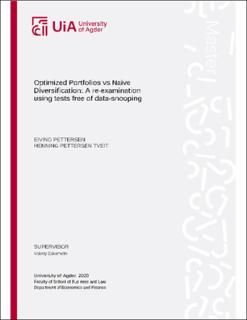| dc.contributor.author | Pettersen, Eivind | |
| dc.contributor.author | Tveit, Henning Pettersen | |
| dc.date.accessioned | 2020-09-30T07:31:02Z | |
| dc.date.available | 2020-09-30T07:31:02Z | |
| dc.date.issued | 2020 | |
| dc.identifier.citation | Pettersen, H. & Tveit, H.P. (2020) Optimized Portfolios vs Naive Diversification:A re-examination using tests free of data-snooping (Master´s thesis). University of Agder, Kristiansand | en_US |
| dc.identifier.uri | https://hdl.handle.net/11250/2680409 | |
| dc.description | Master´s thesis in Business Administration (BE501) | en_US |
| dc.description.abstract | Whether optimized portfolio strategies have superior performance to the naïve diversification or not, has been a heated debate since the publication of DeMiguel,Garlappi, and Uppal (2009). The authors evaluated 14 models which arose as suggestions to solve the issues of estimation errors associated with the mean-variance framework (Markowitz (1952)). They concluded that none of these suggestions consistently outperformed the 1/N benchmark. As a result, several studies fol-lowed to claim the opposite. However, more recent critiques have pointed at several issues regarding the testing methodology in these conflicting studies. First, when several strategy performances are tested against some benchmark individually, the results may be affected by data-mining bias. Second, when using Sharpe ratio as the measure of performance, strategies can appear superior due to anomaly effects in the sample of data. We will by our thesis replicate and extend previous research by employing a methodology that considers and deals with the mentioned issues. We will evaluate 9 portfolio strategies against the 1/N portfolio as benchmark. As for testing methodology, we employ White’s reality check (WRC) and its extension,the superior predictive ability test (SPA), to avoid data-mining bias. Further, we adopt the Fama/French Carhart’s (FFC) 4-factor model to account for potential anomalies in our sources of data. Our findings suggest that when these extensions within methodology are employed, none of the optimized strategies tested are significant for US data. However, when simulating the same strategies in Norwegian returns, our test results report that the three best performing strategies outperform the benchmark significantly. | en_US |
| dc.language.iso | eng | en_US |
| dc.publisher | University of Agder | en_US |
| dc.rights | Attribution-NonCommercial-NoDerivatives 4.0 Internasjonal | * |
| dc.rights.uri | http://creativecommons.org/licenses/by-nc-nd/4.0/deed.no | * |
| dc.subject | BE501 | en_US |
| dc.title | Optimized Portfolios vs Naive Diversification: A re-examination using tests free of data-snooping | en_US |
| dc.type | Master thesis | en_US |
| dc.rights.holder | © 2020 Eivind Pettersen & Henning Pettersen Tveit | en_US |
| dc.subject.nsi | VDP::Samfunnsvitenskap: 200::Økonomi: 210::Samfunnsøkonomi: 212 | en_US |
| dc.source.pagenumber | 58 | en_US |

